“Improbable Cause”
Written by Robert Lederman & David R. Long and Rene Echevarria
Directed by Avery Brooks
Season 3, Episode 20
Production episode 40512-465
Original air date: April 24, 1995
Stardate: unknown
Station log. Garak and Bashir argue over Shakespeare, with Garak complaining that he saw Brutus’s betrayal coming a mile off, so why didn’t Caesar, the leader of a great empire, see it? They modulate to discussing human tendency to rush through their meals, and then go their separate ways. A few minutes later, Bashir’s conversation with Kira about visiting dignitaries is interrupted by an explosion in Garak’s shop—with Garak in it.
After Bashir whisks Garak to the infirmary, O’Brien and Odo assess the damage. The explosion was caused by a rupture in a conduit that overloaded; O’Brien detects nitrilin, which Odo thinks is an indicator of a micro-explosive.
Garak, of course, can’t think of anyone who would wish him harm. He also denies that he was in the Obsidian Order, and insists that his exile was due to not paying his taxes. Odo goes off to pursue the bullshit leads Garak gives him (dissatisfied customers, someone he owes money to, Kira), and Garak wonders why nobody believes him even when he’s being honest. Bashir tells him the story of the boy who cried wolf, with the moral that if you lie all the time, no one will believe you when you tell the truth. Garak, though, thinks there’s another moral: never tell the same lie twice.

Later, Odo summons Garak to his office to look at the passenger manifests of ships that came recently to the station. While he does so, O’Brien has a follow-up report: he’s found the remains of something Odo recognizes as a pheremonic sensor, one attuned to go off upon detecting a particular species. In this case, likely Cardassian (a good trigger, since Garak’s the only one of his species currently living on the station). Said scanners are favored by Flaxians, and there’s one on the station, Retaya, whom Odo interrogates. He’s a merchant who deals in fabrics and fragrances, and Odo quickly determines that he’s a poisoner, using his perfumes and colognes—harmless while separate, deadly when mixed.
Odo has O’Brien put a tracker on the Flaxian’s ship. Odo gets into the Rio Grande—where Garak is already waiting. Odo doesn’t particularly want Garak’s company, but Garak stubbornly refuses to leave, and the Flaxian is getting away, so Odo reluctantly takes him along. They don’t get very far, as the Flaxian ship explodes when it goes into warp.
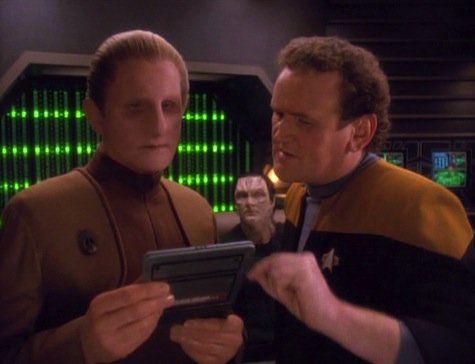
It looks like a simple malfunction, but O’Brien’s tracker’s telemetry reveals a forced neutrino inversion right before the explosion, which indicates a Romulan explosion. Garak has no idea why the Romulans would want him dead—and the fact that he simply says he has no idea indicates to Odo that he’s telling the truth, because if he did know, he’d be spinning an elaborate web of lies on the subject.
Sisko and Odo contact the Tal Shiar, who freely admit that they killed Retaya, as he was wanted for capital crimes against the Romulan Empire. But that doesn’t explain why the Romulans would hire the Flaxian to kill Garak—Odo doesn’t even know for sure that that’s the situation. Questioning Garak is a fruitless endeavor, and questioning the Obsidian Order about someone who may or may not be a former agent is just as fruitless, but Odo does have a source he can call on. He takes a runabout to a planet that has the same cave set as every other planet in the Star Trek universe, and meets with an informant, who refuses to let Odo see him, as he changed his appearance since last they met, and he doesn’t want Odo to see his new face.
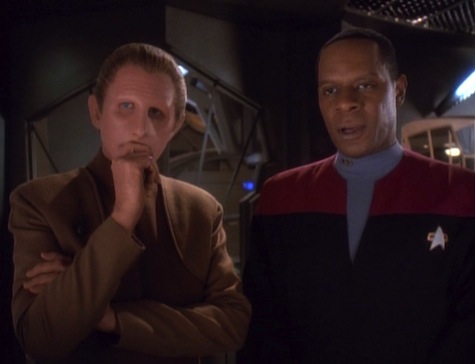
The informant confirms that the Romulans targeted Garak. In addition, there has been odd Romulan activity near the Cardassian border, and five other former operatives of the Obsidian Order died in the last day, three of natural causes, two from accidents. The informant gives Odo a list of the five operatives, and Odo agrees that providing him with this list satisfies the informant’s debt to Odo.
Garak is, in fact, thrilled to see that those five operatives, all well known to him, are dead. He still insists he wasn’t part of the Order, but then Odo drops the bombshell: Garak blew up the shop, not the Flaxian. The Flaxian’s a poisoner, not a bomber; Garak spotted the assassin, and blew up the shop so that Odo would start an investigation.
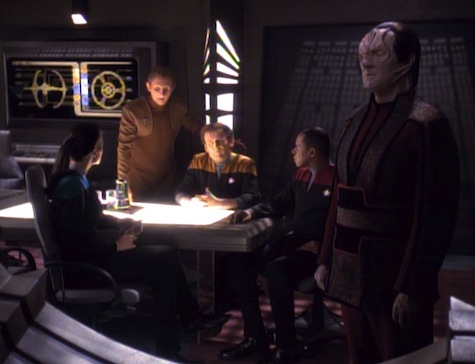
Finally, Garak admits that all six of the operatives in question were the most trusted advisors of Enabran Tain, the retired head of the Order—who may also be a target. Garak contacts Tain’s home, and speaks to his housekeeper, Mila. Garak is obviously quite fond of Mila, and she urges Garak to help Tain, who left suddenly the day before without telling her where.
Bashir sees Garak off as he and Odo take a runabout. They head to a safehouse of Tain’s that Garak isn’t supposed to know about. Odo deduces that Tain was Garak’s mentor, and that despite Tain’s being the one responsible for Garak’s exile, he’s still willing to risk his life to help Tain.
When they arrive at the safehouse’s location, a Romulan warbird decloaks and locks on with a tractor beam. Odo tries to get out a distress signal, but the Romulans jam it, so it may not have gotten through. Two Romulans beam over and take Odo and Garak on board—to Tain, who’s waiting at a desk. “So glad you came—saves me the trouble of sending someone else to kill you.”
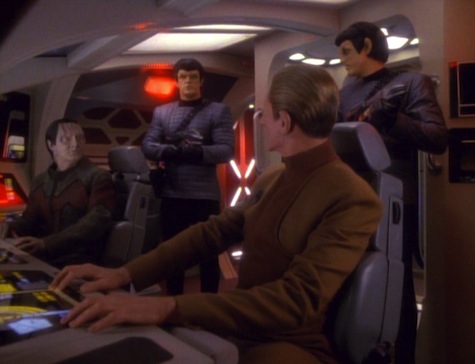
Tain has come out of retirement and he’s leading a joint Romulan/Cardassian task force into the Gamma Quadrant to attack the Dominion. Garak didn’t think anyone in Central Command had the balls to do this—and he’s right. It’s a collaboration between the Order and the Tal Shiar, not involving either nation’s military. The Order has been building ships in the Orias system for months (as we saw in “Defiant”), and their plan is to bombard the Founders’ homeworld. The Romulans learned the location of it from Starfleet, thanks to the latter sharing intelligence, and they shared it with the Order.
Garak is more concerned with matters closer to home: why Tain ordered him and the other five killed. Tain says that he plans to stay un-retired, so he needed those six killed because they know too much. But Tain is impressed with how Garak avoided being assassinated, and so he gives him two options: freely go back to Deep Space 9 without further attempts on his life, or rejoin Tain in the Order.
It’s not even a choice: Garak takes Tain’s hand, proudly declaring, “I’m back.”
To be continued…
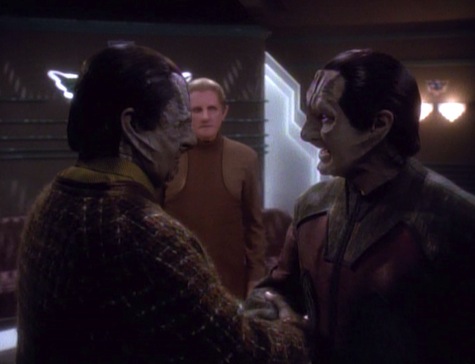
Can’t we just reverse the polarity? Flaxian assassins use pheromone detectors in order to acquire their targets, while Romulans use neutrino inversion in their explosives (kinda disappointed they didn’t find a molecular-decay detonator, just for consistency’s sake with the last Romulan explosive we saw in TNG’s “Reunion”).
Preservation of matter and energy is for wimps. Odo kicks seventeen kinds of ass in this episode, masterfully interrogating Retaya (his banter on the subject of buying perfume for a lady friend is delightful), figuring out that Garak blew up his own shop (something Garak’s mentor didn’t even realize), calling in a favor from a Cardassian informant, and figuring out Garak’s motivations for helping Tain.
Plain, simple. Garak only kicks fifteen kinds of ass. He does a beautiful job of getting Odo to take the investigation seriously (just asking for help wouldn’t work, after all, because nobody would believe him), and his alternate moral for the boy who cried wolf is a masterstroke, but he’s actually surprised a couple of times: when Retaya is killed, when Odo figures out that he blew up the shop, and when Tain turns out to be all right. He also wonders if Odo actually cares about anyone, and doesn’t get anything out of him, with Odo just saying that if there was such a person, he wouldn’t tell Garak about it.
For Cardassia! Tain is the only head of the Obsidian Order ever to live long enough to retire. And he doesn’t stay retired, as he’s conceived an audacious plan to wipe out the Dominion threat before it can really kick in.
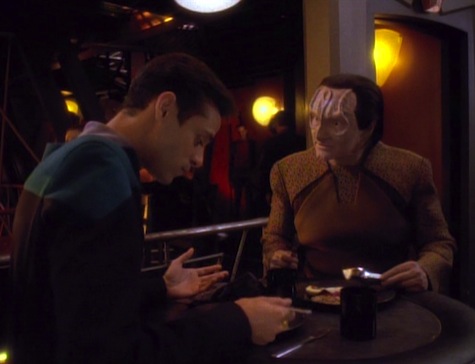
Keep your ears open.
“Is there anything you need me to do while you’re gone?”
“Like what?”
“I don’t know. Any unfinished business?”
“Actually, Doctor, there is something.”
“Oh? What?”
“If you go into my quarters and examine the bulkhead next to the replicator, you’ll notice there’s a false panel. Behind that panel is a compartment containing an isolinear rod. If I’m not back within 78 hours, I want you to take that rod, and eat it.”
“Eat it?”
“Mhm.”
“You’re joking.”
“Yes, Doctor, I am.”
Bashir being friendly and Garak being mischievous, while subverting the clichés of television. (The irony being when this was a one-part episode, that isolinear rod was an important piece of information that Bashir was to release if Garak wasn’t back in 78 hours, but the writers couldn’t make that work without it being hokey.)
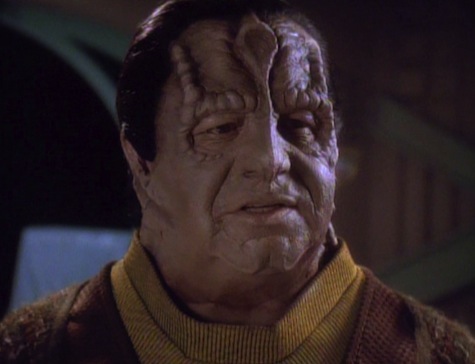
Welcome aboard. More Andrew J. Robinson! That’s three in a row for Garak (in some form or other), with the added bonus of the triumphant return of Paul Dooley as Tain, last seen in “The Wire.” Both will be back for “The Die is Cast” next time.
Carlos LaCamara plays Retaya, Darwyn Carson plays the Tal Shiar operative, and Julianna McCarthy makes the first of three appearances as Mila, Tain’s housekeeper, a role she’ll return to in the final two episodes of the series, “The Dogs of War” and “What You Leave Behind.”
And finally, the great Joseph Ruskin makes a mostly vocal appearance (which is fine, as Ruskin has one of the best voices ever) as Odo’s informant. Ruskin previously appeared as Tumek in “The House of Quark” as well as Galt in the original series’ “The Gamesters of Triskelion.” He’ll be back as Tumek in “Looking for par’Mach in All the Wrong Places,” and also appear in Star Trek: Insurrection, Voyager’s “Gravity,” and Enterprise’s “Broken Bow.”
EDITED TO ADD: After this post went live, I learned that Ruskin died of natural causes at the age of 89 this week. Rest in peace, O ye of the awesome voice…

Trivial matters: The original intent was for this to be a single episode, and was supposed to be a sequel to “Second Skin,” with the assassin targeting Garak because he killed Entek in that episode. It was changed to instead be a sequel to “Defiant,” explaining what the titular ship found in the Orias system after Tom Riker stole it, but the writing staff continued to struggle with the ending, until Michael Piller suggested making it a two-parter.
That suggestion was Piller’s last as co-executive producer of the show. He cut back to the title of creative consultant starting with this episode, focusing his energies on Voyager and a Western he and Bill Dial created called Legend for UPN. (Legend was actually quite excellent, but tragically short-lived. It starred Richard Dean Anderson—between MacGyver and Stargate SG1—as an author and John deLancie—Q his own self—as an inventor.) Ira Steven Behr had already more or less taken over the writers room this season anyhow, with Piller’s focus on getting Voyager launched, and with this episode it becomes official.
That suggestion also mucked with the production order, as the decision to make this a two-parter was made when “Through the Looking Glass” was already in pre-production. As a result, this episode was filmed first, then “Looking Glass,” then “The Die is Cast.”
This is the first Trek two-parter where each episode had a different title, a tradition DS9 would continue henceforth (although the two-hour episodes “The Way of the Warrior” and “What You Leave Behind” would be broken into same-titled two-parters for syndication), and which would also be used a few times in Enterprise’s fourth season.
Mila appears extensively in Andrew J. Robinson’s “autobiography” of Garak, A Stitch in Time, which reveals why Garak is so fond of her. She also appears in the short story “Face Value” by Una McCormack in the Prophecy and Change anthology.
This episode not only establishes just what it was the Obsidian Order was building in the Orias system in “Defiant,” but also explains how the Order knew about the Defiant’s cloaking device in that episode.
We also see a new Tal Shiar uniform, different (and less shoulder-paddy) from the one worn by Troi in “Face of the Enemy.” This was apparently done at the rather loud request of Ronald D. Moore.
Walk with the Prophets. “The truth is usually just an excuse for a lack of imagination.” A great episode that sets the stage for another great episode, which will in turn set the stage for the series going forward.
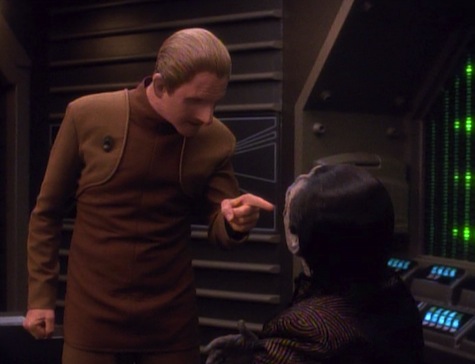
But to start, we get a magnificent study of two of the best characters on the show, Odo and Garak, who are both much more alike than they seem at first (which will be even more explicit in the next part).
Most of the episode is a straight-up whodunit plot, but what’s fun about it is that who is less important than the why, and what was done turns out to be, as Joseph Ruskin’s informant (whom I really wish we’d seen more of) puts it, a small piece of a bigger puzzle. And the plot unfolds so wonderfully, from Garak’s obfuscation to Odo’s interrogation of the Flaxian to some cracks in Garak’s assured armor (the biggest being his conversation with Mila, the first sign we’ve ever seen that Garak actually cares about anyone).
Indeed, there so many great Garak moments here, from his reinterpretation of the boy who cried wolf (one of the great moments in all Trek history, that) to his broad smile when O’Brien finds the pheromone detector to his gleeful tweaking of Bashir when he and Odo head out to his detailed psychological profile of Odo (which is only about half right, unlike Odo’s similar examination of Garak, which is on the nose).
And then we get the truth, hinted at in “The Wire” and “Second Skin,” and brought to the fore here: Garak was indeed an agent of the Order, and it was Tain, his former boss, who exiled him to Terok Nor (later Deep Space 9) for betraying him. The exact nature of the betrayal is never spelled out (here or in “The Die is Cast”), but Tain’s willing to forget it and put him back in the saddle.
A saddle that Garak gleefully jumps into, just as the Tal Shiar and the Obsidian Order are planning a big-ass strike at the Dominion. On the one hand, Garak shaking Tain’s hand seems like a minor cliffhanger as these things go, but the implications of what’s about to happen next are staggering—but we’ll cover that more next time…
Warp factor rating: 10
Keith R.A. DeCandido wishes everyone the happiest of new years and fondest wishes for a truly spectacular 2014.










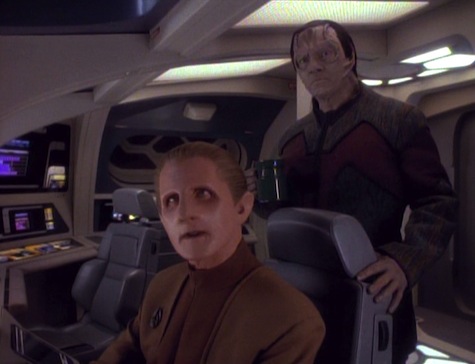
This was a terrific Odo episode, a nice detective story with a clever payoff. I think I like that aspect of it better than the stuff with the invasion fleet and the Obsidian Order and all that. Auberjonois is in great form here and gets some nice material. I would’ve loved to see more episodes that were just Odo solving mysteries. Heck, that should’ve been the next spinoff!
And Keith, you’re absolutely right — Piller’s Legend was brilliant. It’s frustrating that it’s not out on DVD. And it’s frustrating that the nascent UPN did such a bad job promoting it. From the beginning, they should’ve paired it with Voyager and promoted it as “From the co-creator of Star Trek: Voyager.” But by the time they finally started doing those things, they’d already made the decision to cancel it.
And Anderson and De Lancie were more than just “an author” and “an inventor” — they were basically playing pastiches of Mark Twain and Nikola Tesla, who teamed up to fight crime with steampunk superscience. And why a show with a concept that amazing isn’t still on the air is beyond comprehension.
I loved this episode. Watching Odo solve crimes is truly a joy to behold. Seeing Odo and Garak sparring even more so. This is a great beginning to a great two-parter.
Bobby
One of the things I like about this episode is how the scope of it just sneaks up on you. You don’t go in thinking this is going to be a two-parter.
@1 they have the first episode at least on Youtube
I loved Garak’s line about never telling the same lie twice. I had never heard it before this episode. Is it from somewhere else or did one of the writers come up with it?
@5: I’m sure it was original to the script rather than some kind of well-known saying, although of course it’s quite possible that somebody somewhere in human history said it before.
Really, though, I don’t get what’s so brilliant about it. I think it’s actually a pretty bad idea. I thought one of the most important rules of successful deception was to keep one’s story consistent. If you tell a lie, you stick with it, because if you keep changing your story, nobody will believe you anyway.
But then, I always did think that Garak didn’t really know what he was doing. I mean, what kind of competent spy or deceiver goes out of his way to act suspicious and untrustworthy all the time? What kind of master of deception can he be when everyone knows that everything he says is a lie? That’s why I have trouble buying that Garak was the darling of Enabran Tain. Sorry, Garak fans, but all indications are that he is absolutely terrible at his job. Like James Bond, he’s portrayed in a way that makes for an entertaining and colorful character but is completely unbelievable as an actual intelligence operative.
EDIT: Whoa… hold on, though… I just realized there’s another fictional spy that Garak’s personality and mannerisms bear a striking resemblance to, and that’s Napoleon Solo (Robert Vaughn) from The Man from U.N.C.L.E. They both had similarly flamboyant, arch deliveries, always acting smugly amused as if at some private joke. And one of the more active writers on TMFU was Peter Allan Fields, who was a producer on DS9’s first two seasons. I wonder, is it possible there was a deliberate influence there? Could Garak’s mannerisms be an homage to Robert Vaughn? I think if it were, I would’ve heard something about it before, and I don’t remember any such thing. But there are striking similarities.
Christopher: Given Fields’s presence on the writing staff and the fact that Garak being in a tailor shop was a deliberate homage to U.N.C.L.E., yeah I’m sure that’s on purpose.
Also, more generally, I think Garak’s behavior on DS9 was in part to keep himself entertained. This will be more noticeable in Part 2 when Garak is back in spy mode and a lot, well, nastier. Not overwhelmingly so, but he doesn’t do quite the same level of dancing around and metaphorical winking and such when he’s being a spy with Tain and Lovok.
—Keith R.A. DeCandido
@7: “Also, more generally, I think Garak’s behavior on DS9 was in part to keep himself entertained.”
That’s what I always thought. One of my DS9 pitches to Robert Hewitt Wolfe back in ’96 was for a story based on the premise that Garak felt it necessary to play games with people to keep his mind sharp, and so he tried to manipulate events toward a certain outcome with various subtle hints dropped here and there, with no ultimate goal beyond the game, the intellectual challenge to help him cope with the tedium of his exile. But Wolfe felt Garak needed a more concrete goal.
Over the years I like to tell people in the know that “Improbable Cause” and its followup “The Die Is Cast” is to Deep Space Nine what “Coming of Shadows” is to Babylon 5. Anyone who watched and loved both series as I did will understand what I mean. It marked a turning point to a higher level of storytelling from which the show would never look back. To this day I think the two eps represent the best hours of DS9 and, yes, that is saying something.
@9: Yeah, from a narrative perspective, I still enjoy how this duology is one of the key junctures of the entire Dominion story arc. I have more to say which I’ll save for Keith’s next post.
In the interim, I want to finally post that comment I’ve had ready since “Visionary”. It’s interesting to contrast the Tal Shiar’s approach with the Romulan navy’s approach in “Visionary”.
The military’s plan was really a short-term solution, if you think about it. Yeah you destroy the Wormhole, but the Dominion’s still out there — and God help you if they get their hands on transwarp drive or quantum slipstream.
The Tal Shiar’s approach is more ambitious and frankly, the better plan since it neutralizes the threat at its source rather than closing the door and hoping the wild set’leth doesn’t come back.
@10: Well, whether it was really such a great plan is something we can talk about next time.
@1 Legend could do quite well today with it’s heavily Steampunk threads, but even then it may have hard time since Steampunk it heavily attached to the idea of Victorian England and Europe with only some ideas of a Steampunk US, and those focused on the East Coast or the Civil War. However, there is little that is similar on broadcast or cable TV since we seem to be more interested in the paranormal, crime, or some SF. I’m not saying it shouldn’t be done, and novelty alone would help it quite a bit, just that it would be really different from everything else. And that is the idea and point of it.
Otherwise this is one of my favorite DS9 eps of all time and the next bit is pretty damn good as well.
A very good and very pivotal episode, no question. And it also stands out even more since there has been such a run of poor to mediocre episodes leading up to it. If there’s a quibble to be had here, it’s that the Obsidian Order is still capable of participating in this preemptive strike after having their secret fleet revealed. The implication at the end of “Defiant” was that the Cardassian military and civilian authorities were going to come down hard on the OO and strip them of both fleet and power.
Re Garak’s alternate interpretation, there a couple of factors here. First of all, at least as far as the shepherd boy goes Garak was completely correct. Had he chosen a different lie every time he got bored, people would have responded to him when a real wolf came along. More importantly, though, we need to see this through a Cardassian perspective. Consider Garak’s fondness for Cardassian mysteries in which the point is not to figure out whoudunit, but rather who done what; everybody’s guilty of something. In that situation, his obfuscation is far more useful. Also, I agree that it’s largely because he’s bored and just out to amuse himself.
I can see Garak playing the mental games to keep himself sharp and for kicks whilst also waiting for his Big Chances during those years. Christopher and RHW were both absolutely right about him on this point.
Oddly enough, Joseph Ruskin’s obit was made public this week.
http://www.cnn.com/2013/12/31/showbiz/joseph-ruskin-obit/index.html?iref=allsearch
He apparently died on 12/28/2013.
@6-8 But is Garak really a spy? I’ve always thought of the Obsidian Order as something of a secret police in Cardassian society — a group that’s keeping an eye on EVERYONE and manipulating them towards its own goals. In that context, Garak may have sometimes been a spymaster who was giving directives to and collecting information from multiple spies in the field. But his main role would have been as part of a powerful organization trying to control the public institutions from the shadows. Seems like that’s often how he’s been portrayed in the novels as well.
@12: I’m not so sure about that European connection, since Legend was actually the third Western of the type that we would today call steampunk; it was preceded by The Wild Wild West and The Adventures of Brisco County, Jr.
@11: Heh, quite true, CLB.
On the topic of Legend, I thought that in general UPN was too quick to give up on its shows. That first winter, when UPN and WB both launched, every show on both networks, with the exception of Voyager, was reliably at the very bottom of the ratings. But while WB let the shows stick around for a while and find both their voices and an audience, UPN cancelled pretty much everything. I think that was a big part of why WB found a niche, at least for a while, and I don’t think UPN ever really did.
@16… I think that the Obsidian Order is probably more like the former Soviet Union Komitet gosudarstvennoy bezopasnosti- aka the KGB– which included both internal security, international espionage and secret police more than any Western-style, 20th Century intelligence agency where the roles of internal security and foreign intelligence were kept seperate. From what we know of Garak’s activities as a member of the Order, it seems that he mostly functioned externally as spy and assasin, although he seems to have done some internal security work as well. It is unclear though whether that was typical of all members of the order or whether Garak had a somewhat unusual career path because of his father being Tain
@6: Garak didn’t seem to be a traditional intelligence operative during his time at the Obsidian Order. From what we know of his career there it seems like he was primarily involved with doing “wetwork” rather than doing undercover work or cultivating intelligence sources. As such his skill at deception would be much less important to his work than his ruthlessness, technical abilities and skills at infiltration.
I edited the Welcome Aboard section to include a note about Joseph Ruskin’s death. *sadface*
—Keith R.A. DeCandido
It’s possible that Garak is just trying to throw you off by acting like a bad spy, which means he is a really good spy ;)
Although I didn’t really get his alternative moral or find it to be such a stroke of genius – whether or not you tell the same lie, or different lies, if you’re a liar nobody is going to trust you. Unless his point is that you wouldn’t get caught, but that kinda doesn’t make sense either, and that applies whether or not you are telling the same/different lie.
I think Garak understood that it’s often useful to have your opponents underestimate your abilities, and from Garak’s point of view, everyone was an opponent. As the only Cardassian left on the station, many people there would assume he was a spy, and the more he tried to act like he wasn’t a spy the more those people would dig into his past trying to prove he was. By acting like a bad spy, he gave them enough of what they expected to prevent them from really looking deeply into who he had been and what his true abilities are. He didn’t exactly fool Odo, but everyone else had him classified as “Garak, probable former spy, mostly harmless.”
@1, to be a light at the end of the tunnel (at least for me), while it is sad that Legend didn’t last, at least it freed up Richard Dean Anderson to play on Stargate SG-1, which he did so excellently. He even got to reteam with DeLancie on there for a bit, thought not long enough for me.
@25: I think Ernest Pratt (his Legend character) was a better showcase for Anderson’s talents than Col. O’Neill was. Granted, O’Neill ultimately ended up being much the same kind of dissolute wisecracker that Pratt was, but at least in Pratt’s case it fit the character rather than undermining him. And Pratt was more intelligently, literately dissolute. He had MacGyver’s intellect but none of his wholesomeness. It was, plain and simple, the best role of Anderson’s career, and it’s a tragedy that it was his briefest lead role.
On the topic of ‘never tell the same lie twice’, I feel like it’s a clever response on the face of it, but actually kind of falls apart under the weight of the Boy Who Cried Wolf’s lesson. Whether you tell the same lie repeatedly or a different lie every time, the point is that if you keep lying, and get a reputation for lying, no one’s going to believe you when you tell the truth.
Which is exactly the problem Garak has, to his own bemusement (or perhaps amusement?).
@10 I’m going a bit fanboy here, but given how far both factions are supposed to roam (weren’t there hints of changelings in the alpha quadrant centuries before DS9?) did the Dominion and the Borg ever encounter eachother?
@10: The other issue with blowing up the wormhole is that the Founders probably have the patience to send a ship, and 70 years later after the Alpha Quadrant has forgotten about the Dominion, they can set up a foothold and have secret Jem’Hadar breeding facilities, and begin to infiltrate the major powers and undermine them while building up a fleet.
@6,23, and 27 and anyone else who thinks Garak’s alternative moral doesn’t work:
The way I grew up hearing “The Boy Who Cried Wolf” was more simplistic than the way it was presented in this episode – the boy cries “Wof!” merely to get attention and the very first time the villagers show up he just laughs and they know he was lying. So based on that alone he would already have a reputation as a liar no matter what he did or said on subsequent attempts.
In the version of “The Boy Who Cried Wolf” that Bashir is telling (and the only one Garak has ever heard) the shepherd boy is lonely and wants company. The first time he cries “Wolf!” and the villagers arrive the boy claims that the wolf has run away and they all praise him for his vigilance. So at this point he’s thought of as a hero and not a liar – nobody suspects that there was never a wolf. So Garak’s point is that the next time the boy wants company he has to concoct a completely different story – one that will be believable – he could pretend he is sick, for example, and villagers could come and care for him and watch over the flock while he recovers. The third time he’d have to come up with something else. As long as the boy never gains the reputation for being a liar the villagers will continue to trust him.
This doesn’t apply to Garak on the station, of course, because he was mistrusted by everyone from the beginning of the series.
Beautiful episode, beautiful, as a Garak fan, I loved this two parter.
Re: Boy who cried wolf
I thought Garak’s alternate understanding was clever. If nothing else it showed how deeply the differences between cultures can run.
Also, it does make sense when understood a certain way. I had a relative who tried in vain to hide his drug habit by claiming he got mugged on payday 3 pay periods in a row. He couldve used Garak’s advice.
CLB@1, I know it is nearly 4 years too late but in case you see this, Legend *is* available on DVD now. I just saw it on amazon.com
@33/Catherine: Thanks, I’m aware of that, but I’m not currently in a position to buy it. Once I’m in a more financially comfortable place, though, it’s one of several DVD sets I’d like to buy.
I liked the alternate moral to The Boy Who Cried Wolf, but my favorite line from Garak was: “The truth is usually just an excuse for a lack of imagination.”
Improbable Cause/The Die Is Cast demonstrates what makes DS9 the best Trek for me, the interplay of complex characters, of which Garak and Odo are two of best in the entire franchise.
Underrated was the scene where Odo wouldn’t leave Garak alone at his security terminal in case he starts searching through his security files, to which Garak teases “What makes you think I haven’t already done so?” to the visible shock of Odo lol. “Just joking” says Garak satisfied with the reaction he drew, but was he joking? ha ha
Lockdown Rewatch. A truly great episode of Trek and of Television in general, Putting two of Treks greatest ever characters in Odo and Garak out front and centre was an absolute masterstroke. I am glad the main review picked out Garak’s reinterpretation of the boy who cried wolf parable, when I first heard that back in the 90s I found myself thinking you know he has a point there. Not a bad scene or performance in the episode easily a deserved 10 out of 10.
When I first saw Improbable Cause, I thought Mila was being played by Salome Jens rather than Juliana McCarthy. She seems to have the exact same mannerisms and vocal inflections, if not Jens’ unflappable calm.